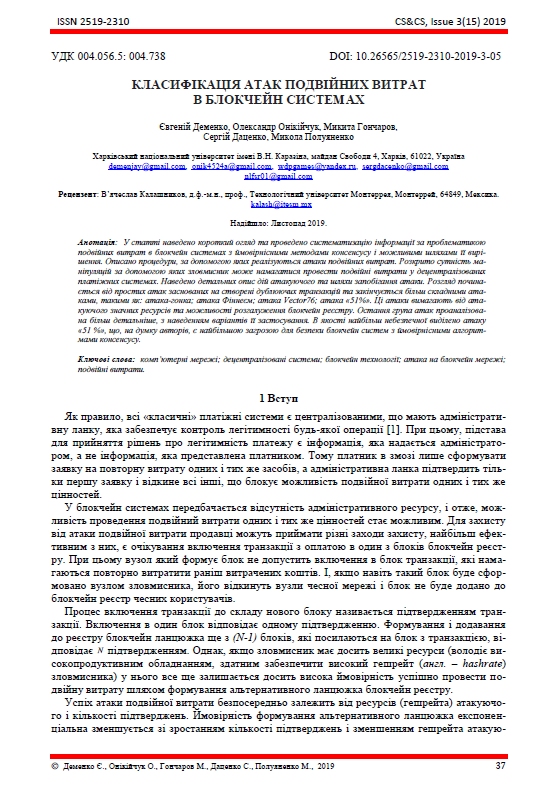Класифікація атак подвійних витрат в блокчейн системах
Анотація
У статті наведено короткий огляд та проведено систематизацію інформації за проблематикою подвійних витрат в блокчейн системах з ймовірнісними методами консенсусу і можливими шляхами її вирішення. Описано процедури, за допомогою яких реалізуються атаки подвійних витрат. Розкрито сутність маніпуляцій за допомогою яких зловмисник може намагатися провести подвійні витрати у децентралізованих платіжних системах. Наведено детальних опис дій атакуючого та шляхи запобігання атаки. Розгляд починається від простих атак заснованих на створені дублюючих транзакцій та закінчується більш складними атаками, такими як: атака-гонка; атака Фіннеєм; атака Vector76; атака «51%». Ці атаки вимагають від атакуючого значних ресурсів та можливості розгалуження блокчейн реєстру. Остання група атак проаналізована більш детальніше, з наведенням варіантів її застосування. В якості найбільш небезпечної виділено атаку «51 %», що, на думку авторів, є найбільшою загрозою для безпеки блокчейн систем з ймовірнісними алгоритмами консенсусу.
Завантаження
Посилання
Centralized, Decentralized, and Distributed Payment Mechanisms. [Online]. Available: https://www.aier.org/article/centralized-decentralized-and-distributed-payment-mechanisms/
M. Rosenfeld, Analysis of hashrate-based double-spending, 2014. [Online]. Available: arXiv preprint arXiv:1402.2009
A. Gervais, H. Ritzdorf, G. O. Karame, S. Čapkun, "Tampering with the delivery of blocks and transactions in Bitcoin”, in CCS 2015 - Proceedings of the 22nd ACM SIGSAC Conference on Computer and Communications Security, vol. 2015-October, pp. 692-705), Association for Computing Machinery. [Online]. Available: https://doi.org/10.1145/2810103.2813655 https://eprint.iacr.org/2015/578.pdf
E. Zaghloul, T. Li, M.W. Mutka, J. Ren, Bitcoin and Blockchain: Security and Privacy, 2019. [Online]. Available: ArXiv, abs/1904.11435
BitcoinWiki: Double-spending. [Online]. Available: https://ru.bitcoinwiki.org/wiki/Double-spending
А. Н. Ширяев, Вероятность: В 2-х кн. Кн. 1. Москва: МЦНМО, 2007.
The Bitcoin Mempool – A Beginner’s Explanation. [Online]. Available: https://99bitcoins.com/bitcoin/mempool/
Hackernoon: Two Ways to Double-Spend. [Online]. Available: https://medium.com/hackernoon/bitcoin-core-bug-cve-2018-17144-an-analysis-f80d9d373362
BitcoinCore: CVE-2018-17144 Full Disclosure. [Online]. Available: https://bitcoincore.org/en/2018/ 09/20/notice/
Blockchain Attack Vectors: Vulnerabilities of the Most Secure Technology. [Online]. Available: https://www.apriorit.com/dev-blog/578-blockchain-attack-vectors
H. Finney, Best practice for fast transaction acceptance - how high is the risk?. [Online]. Available: https://bitcointalk.org/index.php?topic=3441.msg48384#msg48384, Feb. 2011
Bitcoin’s Security Model Revisited. [Online]. Available: https://arxiv.org/pdf/1605.09193.pdf
Ch. Everett, Blockchain Security. [Online]. Available: https://www.simplexityanalysis.com/blog/2016/9/20/blockchain-security
The 51% Attack. What is it? [Online]. Available: https://medium.com/swlh/the-51-attack-what-is-it-d295e70b9ac4
% Attack Explained: The Attack on A Blockchain. [Online]. Available: https://www.fxempire.com/education/article/51-attack-explained-the-attack-on-a-blockchain-513887
П. Колесников, Ю. Бекетнова, Г. Крылов,Технология Блокчейн. Анализ Атак, стратегии защиты. [Online]. Available: https://www.mumcfm.ru/repository/7b9dcd8e4e51d467a0f8e1eff82157e504c569331681beb7e80117fd64e05d1a


